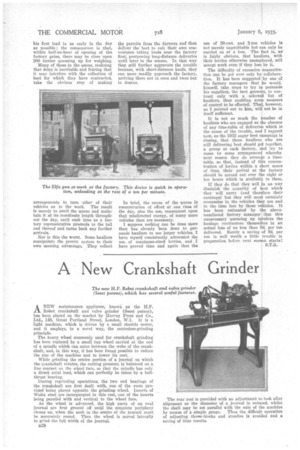A New Crankshaft Grinder
Page 42

If you've noticed an error in this article please click here to report it so we can fix it.
The new H.F. Robot crankshaft and valve grinder (Seest patent), which has several useful features.
ANEW maintenance appliance, known as the H.F. Robot crankshaft and valve grinder (Seest patent), has been, placed on the market by Harvey Frost and Co., Ltd., 148, Great Portland Street, London, W.1. It is a light machine, which is driven by a small electric motor, and it employs, in a novel way, the centreaess-grinding principle.
The heavy wheel commonly used for crankshaft grinding has been replaced by a small cup wheel carried at the end of a spindle which can enter between the webs of the crankshaft, and, in this way, it has been found possible to reduce the size of the machine and to lower its cost.
While grinding the centre portion of a journal on which the crankshaft rotates, the cutting pressure is balanced on a line contact on the wheel face, so that the spindle has only a direct axial load, which can perfectly be taken by a ballthrust bearing.
During regrinding operations, the two end bearings of the crankshaft are first dealt with, one of the rests provided being placed opposite the grinding wheeL Inserts of Widia steel are incorporated in this rest, one of the inserts being parallel with and vertical to the wheel face.
As the wheel is advanced, the high parts of an oval journal are first ground off until the complete periphery cleans up. when the neck in the centre of the journal must he accurately round. Then the wheel is moved laterally to grind the full width of the journal.
The rear rest is provided with an adjustment to look after alignment as the diameter of a journal is reduced, whilst the shaft may he set parallel with the axis of the machine by means of a simple gauge. Thus the difficult operation of adjusting throne-blocks and steadies is avoided and a saving of time results.




























































































